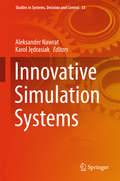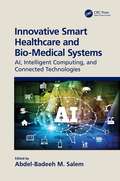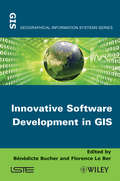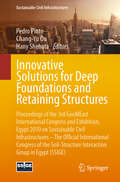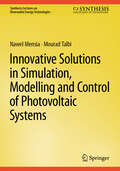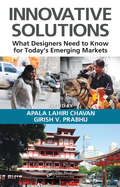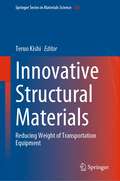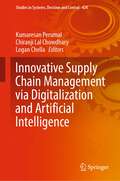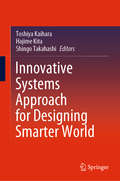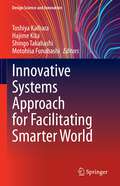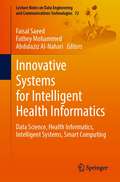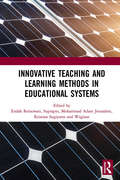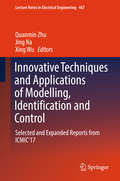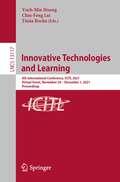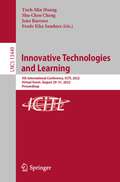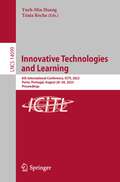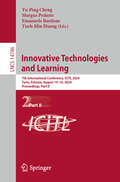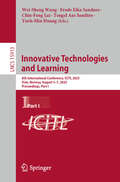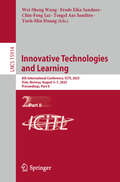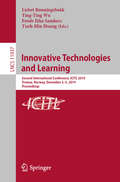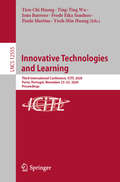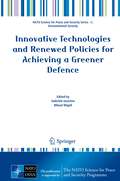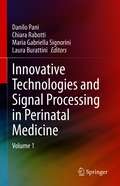- Table View
- List View
Innovative Shear Design (Structural Engineering: Mechanics and Design)
by Hrista StamenkovicInnovative Shear Design presents a new, rational and economical design procedure that offers increased protection against shear for all types of structures. The first part of the book describes the internal forces imposed on any flexurally bent member, and goes on to describe how these can interact with external loading forces to cause failure. The
Innovative Simulation Systems
by Aleksander Nawrat Karol JędrasiakThis monograph provides comprehensive guidelines on the current and future trends of innovative simulation systems. In particular, their important components, such as augmented reality and unmanned vehicles are presented. The book consists of three parts. Each part presents good practices, new methods, concepts of systems and new algorithms. Presented challenges and solutions are the results of research and conducted by the contributing authors. The book describes and evaluates the current state of knowledge in the field of innovative simulation systems. Throughout the chapters there are presented current issues and concepts of systems, technology, equipment, tools, research challenges and current, past and future applications of simulation systems. The book is addressed to a wide audience: academic staff, representatives of research institutions, employees of companies and government agencies as well as students and graduates of technical universities in the country and abroad. The book can be a valuable source of information for constructors and developers of innovative simulation systems and their components. Scientists and researchers involved in mechanics, control algorithms, image processing, computer vision or data fusion can find many valuable suggestions and solutions.
Innovative Smart Healthcare and Bio-Medical Systems: AI, Intelligent Computing and Connected Technologies
by Salem, Abdel-Badeeh M.Advances in smart healthcare systems (SHS) and artificial intelligence (AI) domains highlight the need for ICT systems that aim not only to improve human quality of life but improve safety too. SHS bring together concepts and methodologies from various fields, such as communications and network systems, computer science, life sciences and healthcare. The well-known smart healthcare paradigms are; real-time monitoring devices, computer-aided surgery devices, telemedicine devices, population-based care devices, personalized medicine from a machine learning perspective, ubiquities intelligent computing, expert decision support systems, Health 2.0 and Internet of Things (IoT). This book presents models for the deployment of intelligent computing, information, and networking technologies to aid in preventing disease, improving the quality of care and lowering overall cost. It also discusses the potential role of the AI paradigms, computational intelligence and machine learning techniques which are used in developing the SHS. It will provide examples of potential usage of such technology in smart healthcare and and bio-medical systems. It will be an important read for researchers and professionals working in smart healthcare systems, as well as those working in the individual areas of networks, artificial intelligence and healthcare who want to see how an interdisciplinary approach can enhance the current technology.
Innovative Software Development in GIS
by Bénédicte Bucher Florence Le BerAt a time when people use more and more geographic information and tools, the management of geographical information in software systems still holds many challenges and motivates researchers from different backgrounds to propose innovative solutions. Representing geographical space beyond our mere perception is key to making relevant decisions, whether it is with respect to sustainable development or to the planning of everyday activities. Designing, sharing and exploiting such representations entails many challenges. This book presents recent software design projects, led in teams, which sometimes have different backgrounds, to address these challenges. It analyzes the specificities of these projects in terms of motivation, data models and analysis methods. Proposals are also put forward to improve resource sharing in this domain. Contents 1. Introduction, Bénédicte Bucher and Florence Le Ber. Part 1. Software Presentation 2. ORBISGIS: Geographical Information System Designed by and for Research, Erwan Bocher and Gwendall Petit. 3. GEOXYGENE: an Interoperable Platform for Geographical Application Development, Éric Grosso, Julien Perret and Mickaël Brasebin. 4. Spatiotemporal Knowledge Representation in AROM-ST, Bogdan Moisuc, Alina Miron, Marlène Villanova-Olivier and Jérôme Gensel. 5. GENGHIS: an Environment for the Generation of Spatiotemporal Visualization Interfaces, Paule-Annick Davoine, Bogdan Moisuc and Jérôme Gensel. 6. GEOLIS: a Logical Information System to Organize and Search Geo-Located Data, Olivier Bedel, Sébastien Ferré and Olivier Ridoux. 7. GENEXP-LANDSITES: a 2D Agricultural Landscape Generating Piece of Software, Florence Le Ber and Jean-François Mari. 8. MDWEB: Cataloging and Locating Environmental Resources, Jean-Christophe Desconnets and Thérèse Libourel. 9. WEBGEN: Web Services to Share Cartographic Generalization Tools, Moritz Neun, Nicolas Regnauld and Robert Weibel. Part 2. Summary and Suggestions 10. Analysis of the Specificities of Software Development in Geomatics Research, Florence Le Ber and Bénédicte Bucher. 11. Challenges and Proposals for Software Development Pooling in Geomatics, Bénédicte Bucher, Julien Gaffuri, Florence Le Ber and Thérèse Libourel.
Innovative Solutions for Deep Foundations and Retaining Structures: Proceedings of the 3rd GeoMEast International Congress and Exhibition, Egypt 2019 on Sustainable Civil Infrastructures – The Official International Congress of the Soil-Structure Interaction Group in Egypt (SSIGE) (Sustainable Civil Infrastructures)
by Pedro Pinto Hany Shehata Chang-Yu OuThis edited book’s theme is organized as a part of the GeoMEast 2019 International Congress and Exhibition that was held in Cairo, Egypt, on November 10–14 2019.The editors like to express their deep appreciation and gratitude to the authors for their valuable contributions to the GeoMEast 2019 proceedings and to all session chairs and reviewers for their sincere efforts to make this book a reality. The editors are very grateful to have this opportunity to participate in organizing this GeoMEast 2019 conference and hope that this book theme is a valuable reference to the civil/geotechnical engineering community worldwide.
Innovative Solutions in Simulation, Modelling and Control of Photovoltaic Systems (Synthesis Lectures on Renewable Energy Technologies)
by Nawel Mensia Mourad TalbiThis book provides innovative methods for simulating, modeling, and controlling photovoltaic systems. The authors introduce a modeling strategy including eight linear models pondered by nonlinear weighting functions that are calculated dynamically based on extreme temperature and irradiance values. The authors demonstrate how the parameters of each model are harnessed to develop a partial PI controller aimed at commanding the corresponding model to achieve the desired performances swiftly and precisely. The books goes on to show how merging the gains of the partial PI controllers with the nonlinear weighting functions, the PI controller gain for the PV system can be effectively determined. The authors present the results of simulation performed in MATLAB/SIMULINK environment to demonstrate the model's ability to depict accurately the behavior of the PV system across all operative zones and under varying climatic conditions. Furthermore, the authors show how the results demonstrate the effectiveness of the proposed PI controller in swiftly and precisely tracking the maximum power point while maintaining stability and canceling ripples.
Innovative Solutions: What Designers Need to Know for Today's Emerging Markets
by Apala Lahiri Chavan Girish V. PrabhuExpanding into emerging markets brings with it a specific set of challenges for designing products and services. Not only do cultural differences play a role in what, how, and why customers behave the way they do, but existing technologies, distribution channels, and the wants and needs of consumers become additional challenges when establishing ma
Innovative Structural Materials: Reducing Weight of Transportation Equipment (Springer Series in Materials Science #336)
by Hiroshi Fukutomi Tomoaki Hyodo Sakurako KotobukiThis book is devoted to innovative structural materials for multi-materialization. It is based on results of a 10-year national project, The Innovative Structural Materials Research and Development Project, which was carried out in Japan, aimed at reducing the weight of materials (steel, aluminum alloys, magnesium alloys, titanium alloys, thermoplastic CFRP, carbon fiber) and components used in transportation equipment such as automobiles. In this project, collaborative research in a total of nine fields including materials, joining, and structural designing was also carried out in order to realize multi-materials. This book is compiled with the aim of handing down the technical and academic results obtained through these research and development activities to the next generation of researchers and students. This book enables material engineers and researchers in the field of materials related to transportation equipment, graduate students in various technical fields, and engineers and researchers belonging to material users to grasp the full picture of material development and multi-materials technologies. For the understanding of engineers and researchers who will work on multi-materials, this book explains the current state of technology and science in each field and explains the innovative results obtained by research in each field.
Innovative Supply Chain Management via Digitalization and Artificial Intelligence (Studies in Systems, Decision and Control #424)
by Chiranji Lal Chowdhary Kumaresan Perumal Logan ChellaThis book focuses on the impact of artificial intelligence (AI) and machine learning (ML) models on supply chain operations in industry 4.0. The chapters illustrate the AI and ML models for all functional areas of operations in SCM. The book also includes examples using ML models like handling supply-to-demand imbalances, triggering automated responses, and reinforcing customer relationships. It describes the evolution of blockchain technology coupled with the ability to automate business logic for the transparency of goods, infrastructure, products, and licenses in software. The book also includes case studies that provide a problem statement and industry overcome by applying ML and AI technologies. This book is suitable for undergraduates, postgraduates, industrial professionals, business executives, entrepreneurs, and freelancers to encourage practical learning on AI and ML algorithms in SCM 4.0. Additionally, this book will provide computer science and information system professionals with the latest technologies embedded in the corporate world.
Innovative Systems Approach for Designing Smarter World
by Hajime Kita Shingo Takahashi Toshiya KaiharaThis book presents an innovative systems approach towards the idea of a smarter world, with advanced and sustainable social infrastructures, facilities and services. It develops a novel systems approach for society-wide systems where interdependent systems encompassing transportation, energy, communication, water, sewerage, logistics, education, disaster prevention, medical care and welfare are integrated to form a ‘System of Systems’ (SoS). Written by leading system scientists and technology creators, it introduces state-of-the-art concepts of and methodologies for systems approaches towards SoS as well as their practical applications, discussing the planning, design and management challenges in their implementation and the potential impact on societies and the environment. The volume will be of interest to systems engineers, system integrators, and researchers in related engineering fields, as well as government policymakers.
Innovative Systems Approach for Facilitating Smarter World (Design Science and Innovation)
by Hajime Kita Shingo Takahashi Toshiya Kaihara Motohisa FunabashiThis book introduces state-of-the-art concepts and methodologies on innovative systems approach that enables the grand design and implementation about Smarter World. This book also describes the shared view that the various heterogeneous social systems that make up Smarter World should be viewed as systems at an abstract level, and develop new developments in SoS and spiral systems through the cycle of analysis, synthesis and abduction. Several new concepts that integrate data-driven mechanism into traditional model-driven methodologies in systems approach are explained with practical applications. As such, it offers a valuable resource for systems engineers, system integrators, and researchers in related engineering fields, as well as government policymakers.
Innovative Systems for Intelligent Health Informatics: Data Science, Health Informatics, Intelligent Systems, Smart Computing (Lecture Notes on Data Engineering and Communications Technologies #72)
by Faisal Saeed Fathey Mohammed Abdulaziz Al-NahariThis book presents the papers included in the proceedings of the 5th International Conference of Reliable Information and Communication Technology 2020 (IRICT 2020) that was held virtually on December 21–22, 2020. The main theme of the book is “Innovative Systems for Intelligent Health Informatics”. A total of 140 papers were submitted to the conference, but only 111 papers were published in this book. The book presents several hot research topics which include health informatics, bioinformatics, information retrieval, artificial intelligence, soft computing, data science, big data analytics, Internet of things (IoT), intelligent communication systems, information security, information systems, and software engineering.
Innovative Teaching and Learning Methods in Educational Systems: Proceedings of the International Conference on Teacher Education and Professional Development (INCOTEPD 2018), October 28, 2018, Yogyakarta, Indonesia
by Kristian Sugiyarto Suprapto Endah Retnowati Jerusalem Mohammad Adam WagironThis proceedings volume of InCoTEPD 2018 covers many ideas for handling a wide variety of challenging issues in the field of education. The outstanding ideas dealing with these issues result in innovation of the system. There are many innovation strategies resulting from recent research that are discussed in this book. These strategies will become the best starting points to solve current and future problems.This book provides an in-depth coverage of educational innovation developments with an emphasis on educational systems, formal or informal education strategies, learning models, and professional teachers. Indeed, those developments are very important to be explored for obtaining the right way of problem-solving.Providing many ideas from the theoretical foundation into the practice, this book is versatile and well organized for an appropriate audience in the field of education. It is an extremely useful reference for students, teachers, professors, practitioners, and government representatives in many countries.
Innovative Techniques and Applications of Modelling, Identification and Control: Selected And Expanded Reports From Icmic'17 (Lecture Notes In Electrical Engineering #467)
by Quanmin Zhu Jing Na Xing WuThis book presents the most important findings from the 9th International Conference on Modelling, Identification and Control (ICMIC’17), held in Kunming, China on July 10–12, 2017. It covers most aspects of modelling, identification, instrumentation, signal processing and control, with a particular focus on the applications of research in multi-agent systems, robotic systems, autonomous systems, complex systems, and renewable energy systems.The book gathers thirty comprehensively reviewed and extended contributions, which help to promote evolutionary computation, artificial intelligence, computation intelligence and soft computing techniques to enhance the safety, flexibility and efficiency of engineering systems. Taken together, they offer an ideal reference guide for researchers and engineers in the fields of electrical/electronic engineering, mechanical engineering and communication engineering.
Innovative Technologies and Learning: 4th International Conference, ICITL 2021, Virtual Event, November 29 – December 1, 2021, Proceedings (Lecture Notes in Computer Science #13117)
by Yueh-Min Huang Chin-Feng Lai Tânia RochaThis book constitutes the refereed proceedings of the 4th International Conference on Innovative Technologies and Learning, ICITL 2021, held in November/December 2021. Due to COVID-19 pandemic the conference was held virtually. The 59 full papers presented together with 2 short papers were carefully reviewed and selected from 110 submissions. The papers are organized in the following topical sections: Artificial Intelligence in Education; Augmented, Virtual and Mixed Reality in Education; Computational Thinking in Education; Design Framework and Model for Innovative learning; Education Practice Issues and Trends; Educational Gamification and Game-based Learning; Innovative Technologies and Pedagogies Enhanced Learning; Multimedia Technology Enhanced Learning; Online Course and Web-Based Environment; and Science, Technology, Engineering, Arts and Design, and Mathematics.
Innovative Technologies and Learning: 5th International Conference, ICITL 2022, Virtual Event, August 29–31, 2022, Proceedings (Lecture Notes in Computer Science #13449)
by Yueh-Min Huang Frode Eika Sandnes João Barroso Shu-Chen ChengThis book constitutes the refereed proceedings of the 5th International Conference on Innovative Technologies and Learning, ICITL 2022, held in Porto, Portugal, in August 2022. The 53 full papers presented together with 3 short papers were carefully reviewed and selected from 123 submissions. ICITL focuses on artificial intelligence in education, VR/AR/MR/XR in education, design and framework of learning systems, pedagogies to innovative technologies and learning, application and design of innovative learning.
Innovative Technologies and Learning: 6th International Conference, ICITL 2023, Porto, Portugal, August 28–30, 2023, Proceedings (Lecture Notes in Computer Science #14099)
by Yueh-Min Huang Tânia RochaThis book constitutes the refereed proceedings of the 6th International Conference on Innovative Technologies and Learning, ICITL 2023, held in Porto, Portugal, during August 28–30, 2023. The 64 full papers included in this book were carefully reviewed and selected from 147 submissions. They cover a wide range of many different research topics, such as: artificial intelligence in education; computational thinking in education; design and framework of learning systems; pedagogies to innovative technologies and learning; STEM/STEAM education; VR/AR/MR/XR in education; and application and design of innovative learning software.
Innovative Technologies and Learning: 7th International Conference, ICITL 2024, Tartu, Estonia, August 14–16, 2024, Proceedings, Part I (Lecture Notes in Computer Science #14785)
by Yueh-Min Huang Emanuele Bardone Yu-Ping Cheng Margus PedasteThe two-volume set LNCS 14785 and 14786 constitutes the refereed post-conference proceedings of the 7th International Conference on Innovative Technologies and Learning, ICITL 2024, Tartu, Estonia, during August 14 -16, 2024. The 60 full papers included in this book were carefully reviewed and selected from 131 submissions. They were organized in topical sections as follows: Part One : Artificial Intelligence in Education; Computational Thinking in Education; Design and Framework of Learning Systems and Pedagogies to Innovative Technologies and Learning. Part Two : STEM/STEAM Education; VR/AR/MR/XR in Education; and Application and Design of Generative Artificial Intelligence in Education.
Innovative Technologies and Learning: 7th International Conference, ICITL 2024, Tartu, Estonia, August 14–16, 2024, Proceedings, Part II (Lecture Notes in Computer Science #14786)
by Yueh-Min Huang Emanuele Bardone Yu-Ping Cheng Margus PedasteThe two-volume set LNCS 14785 and 14786 constitutes the refereed conference proceedings of the 7th International Conference on Innovative Technologies and Learning, ICITL 2024, Tartu, Estonia, during August 14 -16, 2024. The 60 full papers included in this book were carefully reviewed and selected from 131 submissions. They were organized in topical sections as follows: Part One : Artificial Intelligence in Education; Computational Thinking in Education; Design and Framework of Learning Systems and Pedagogies to Innovative Technologies and Learning. Part Two : STEM/STEAM Education; VR/AR/MR/XR in Education; and Application and Design of Generative Artificial Intelligence in Education.
Innovative Technologies and Learning: 8th International Conference, ICITL 2025, Oslo, Norway, August 5–7, 2025, Proceedings, Part I (Lecture Notes in Computer Science #15913)
by Yueh-Min Huang Frode Eika Sandnes Chin-Feng Lai Wei-Sheng Wang Tengel Aas SandtrøThe two-volume set, LNCS 15913 and 15914, constitutes the refereed conference proceedings of the 8th International Conference on Innovative Technologies and Learning, ICITL 2025, held in Oslo, Norway, during August 5–7, 2025. The 82 papers included in these proceedings were carefully reviewed and selected from 214 submissions. The papers are organized in the following topical sections: Part I: Artificial Intelligence in Education; Computational Thinking in Education; Design and Framework of Learning Systems; VR/AR/MR/XR in Education. Part II: Pedagogies to Innovative Technologies and Learning; STEM/STEAM Education; Application and Design of Generative Artificial Intelligence in Education.
Innovative Technologies and Learning: 8th International Conference, ICITL 2025, Oslo, Norway, August 5–7, 2025, Proceedings, Part II (Lecture Notes in Computer Science #15914)
by Yueh-Min Huang Frode Eika Sandnes Chin-Feng Lai Wei-Sheng Wang Tengel Aas SandtrøThe two-volume set, LNCS 15913 and 15914, constitutes the refereed conference proceedings of the 8th International Conference on Innovative Technologies and Learning, ICITL 2025, held in Oslo, Norway, during August 5–7, 2025. The 82 papers included in these proceedings were carefully reviewed and selected from 214 submissions. The papers are organized in the following topical sections: Part I: Artificial Intelligence in Education; Computational Thinking in Education; Design and Framework of Learning Systems; VR/AR/MR/XR in Education. Part II: Pedagogies to Innovative Technologies and Learning; STEM/STEAM Education; Application and Design of Generative Artificial Intelligence in Education.
Innovative Technologies and Learning: Second International Conference, ICITL 2019, Tromsø, Norway, December 2–5, 2019, Proceedings (Lecture Notes in Computer Science #11937)
by Yueh-Min Huang Ting-Ting Wu Lisbet Rønningsbakk Frode Eika SandnesThis book constitutes the refereed proceedings of the Second International Conference on Innovative Technologies and Learning, ICITL 2019, held in Tromsø, Norway, in December 2019. The 85 full papers presented together with 4 short papers were carefully reviewed and selected from 189 submissions. The papers are organized in the following topical sections: application and design of innovative learning software; artificial intelligence and data mining in education; augmented and virtual reality in education; computational thinking in education; design and framework of learning systems; educational data analytics techniques and adaptive learning applications; evaluation, assessment and test; innovative learning in education; mobile learning; new perspectives in education; online course and web-based environment; pedagogies to innovative technologies; social media learning; technologies enhanced language learning; and technology and engineering education.
Innovative Technologies and Learning: Third International Conference, ICITL 2020, Porto, Portugal, November 23–25, 2020, Proceedings (Lecture Notes in Computer Science #12555)
by Yueh-Min Huang Ting-Ting Wu Tien-Chi Huang Frode Eika Sandnes João Barroso Paulo MartinsThis book constitutes the refereed proceedings of the Second International Conference on Innovative Technologies and Learning, ICITL 2020, held in Porto, Portugal, in November 2020. The 65 full papers presented together with 2 short papers were carefully reviewed and selected from 127 submissions. The papers are organized in the following topical sections: Augmented and Virtual Reality in Education; Educational Data Mining and Learning Analytics; Emerging Issues and Trends in Education; Innovative Learning in Education; Online Course and Web-Based Environment; Technology-Enhanced Learning; Application and Design of Innovative Learning Software; and Science, Technology, Engineering, Arts and Design, and Mathematics.Due to the Corona pandemic this event was held virtually.
Innovative Technologies and Renewed Policies for Achieving a Greener Defence (NATO Science for Peace and Security Series C: Environmental Security)
by Mikael Wigell Gabriele IacovinoThis book presents a fresh and original contribution to the debate on the policies and technologies needed to achieve a Greener Defence. It will provide an overall and comprehensive analysis of the current state and future prospects of the public and private discourse on the matter, by leveraging on four different and complementary perspectives: the national experiences of relevant NATO Member States and Partner Countries, the institutional framework of International Organizations, the role of industry and private companies and the intellectual contribution of research centers and academia. It will provide new policy recommendations and advanced and innovative technological solutions to be implemented in order to reduce the environmental footprint of Armed Forces, while improving at the same time the energy efficiency and strengthening the operational capabilities of Militaries. The book is addressed to all those interested in studying the connections between climate change, environmental issues, energy security and the role of Armed Forces, the latter seen as an important actor for reducing the environmental impact of human activities and as a forum where to discuss and implement new green technological solutions and applications.
Innovative Technologies and Signal Processing in Perinatal Medicine: Volume 1
by Danilo Pani Chiara Rabotti Maria Gabriella Signorini Laura BurattiniPregnancy is a critical time for the health of the mother and the fetus, with important potential risks for both. Tools for antenatal diagnosis and pregnancy monitoring can support prevention and management of potential risks and complications. In particular, the perinatal period, spanning from the third trimester of pregnancy up to one month after birth, is the most critical for the baby. For this reason, in the last decades, biomedical engineering supported and fostered the scientific research towards the identification of new models, parameters, algorithms, and tools that can improve the quality of fetal monitoring, predict the outcomes and allow physicians to intervene in an appropriate manner to ensure a healthy future for the baby. This book follows the First International Summer School on Technologies and Signal Processing in Perinatal Medicine and reflects some of its most important master lectures. It represents a valuable guide for students and young researchers approaching this topic for the first time, as well as experienced researchers and practitioners looking for a clear representation of the themes and techniques presented by recognized experts in the field. Presents current and innovative technologies for fetal and neonatal monitoring Emphasis on both technology/signal processing and clinical aspectsOffers a clear didactic approach to the subject matter

